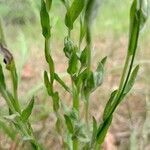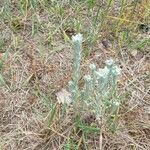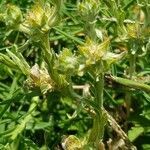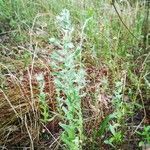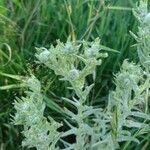Herbs, annual. Stems 5-35 cm tall, erect, paniculately branching, more rarely simple, sometimes forkedly branching in upper portion, with dense whitish or grayish lanate pubescence. Leaves lanceolate or linear-lanceolate, 5-15 × ca. 1.3 mm, with soft lanate pubescence, apex acute. Capitula 2-3 mm, ovate or pyramidal, gathered in 2s-10s into numerous corymbs, arranged at apices of stems and ramuscules and forming paniculate, racemose, more rarely spiciform synflorescences; floral leaves as long as or shorter than capitula. Involucre 2-or 3-seriate; phyllaries stellate-patent after ripening of achenes; outer phyllaries 5-10, closely surrounding female florets, green, in middle scarious, white transparent at margin, linear or lanceolate, cymbiform, 2-3 mm, ecarinate, abaxially with thick continuous gray lanate pubescence, glabrous at apex, slightly acuminate; inner phyllaries 5, becoming green in middle, broadly lanceolate, slightly concave, indistinctly pubescent or glabrous at margin abaxially, acuminate or obtuse. Achenes light brown, oblong-ovate, slightly flattened, 0.8-1 × ca. 0.3 mm, with sparse papillose hairs, larger than in other species of genus. Pappus of female and bisexual florets with 12-15 finely crenate bristles. 2n = 28.
More
Simple or branching annual 0.3–5 dm; lvs erect, linear or nearly so, to ca 4 cm × 5 mm; heads mostly 3–5 mm high, in a racemiform or paniculiform, leafy-bracteate infl; proper invol very scanty; receptacular bracts woolly, simulating an invol, somewhat concave-clasping, obscurely hyaline-margined and-tipped; receptacle nearly flat; 2n=28. European weed, now well established in nw. U.S. and casually in our range, as in Mich. July, Aug. (Logfia a.)
